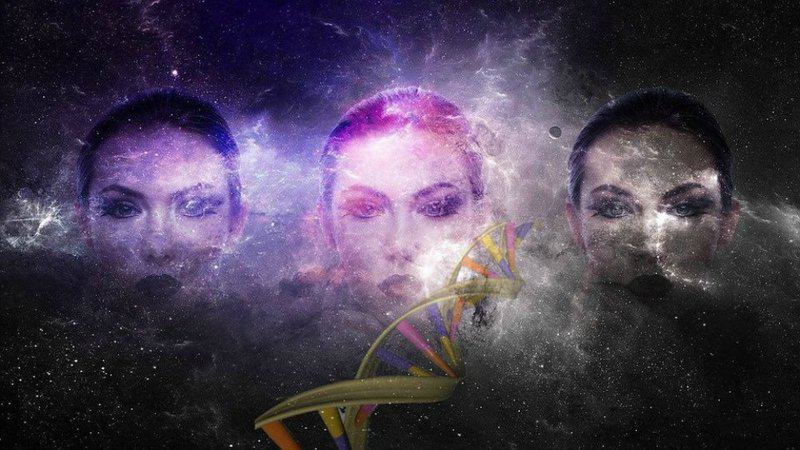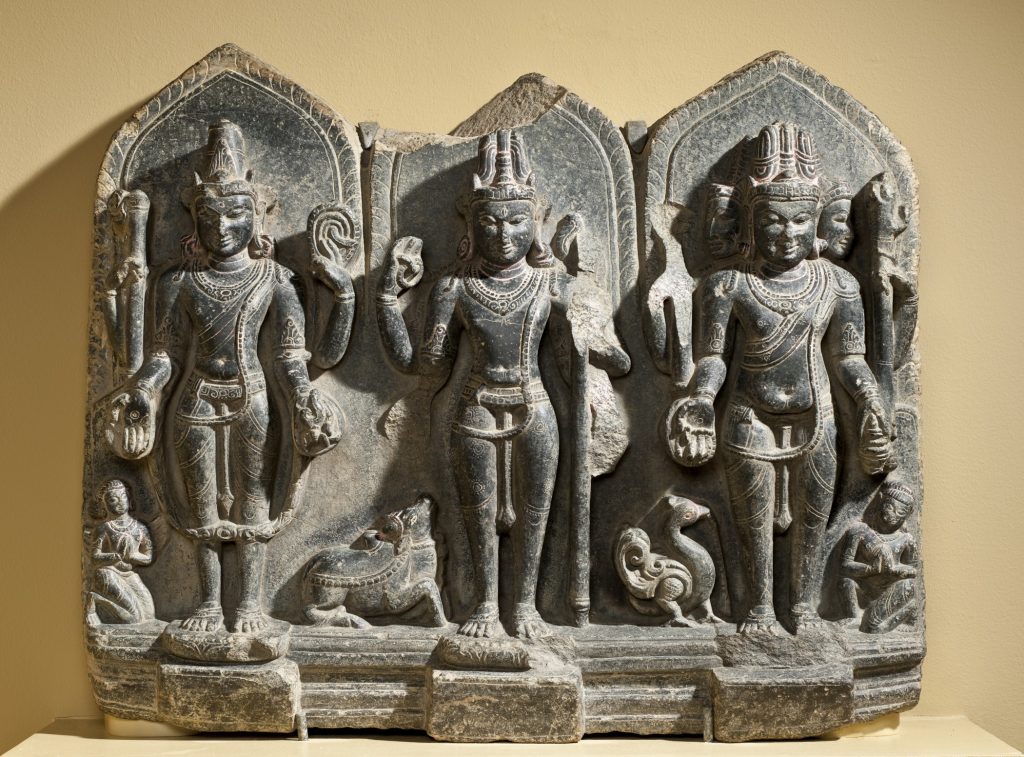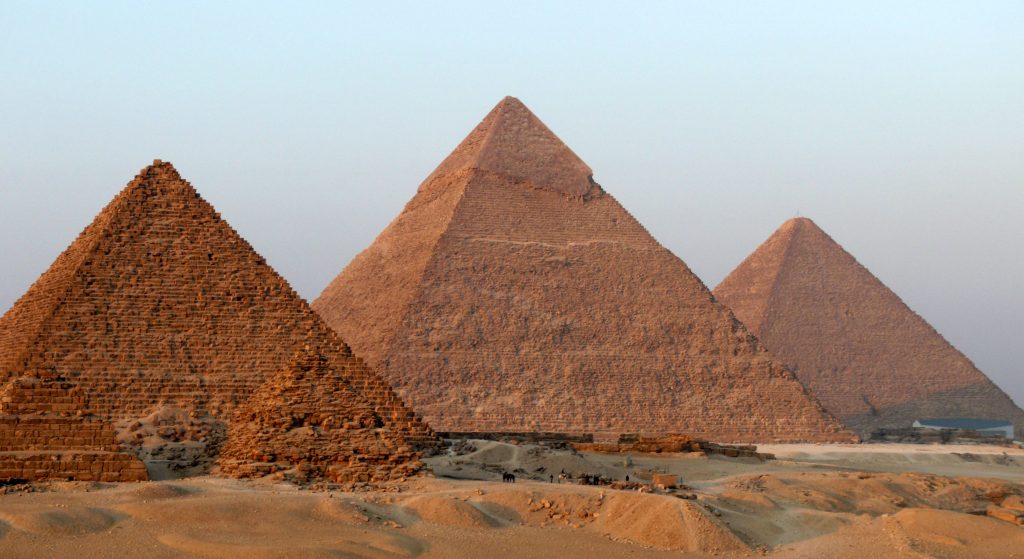
What is it about this number that continues to baffle scientific world? Could this recurring motif contain a profound message?
People of ancient Egypt believed the design and idea of the three pyramids of Giza came from the Gods. Various cultures across the world worshipped divine beings that ruled as all-knowing triads. Famous scientist Isaac Newton searched for the secrets of the universe in an ancient tablet that spoke of the power of the number three. Even the language of our DNA is written in a pattern of threes.
Is it possible that the combination of all the trios and trinities embedded throughout the mythical and religious world suggest that the power of three might somehow connect humanity with divine energy or superior mind?
Three in Religion
Hinduism
In the Hindu religion, the concept of the cosmos is personified by a triad of deities, namely the Trimurti. The Trimurti or triad is also referred to as Brahma-Vishnu-Maheshwara, which stands for Brahma the creator, Vishnu the preserver, and Shiva the destroyer. The three represent the aspects of human existence: birth, life and death. Although there are many depictions of the Trumurti, often they have three heads branching from one neck, each gazing in a different direction.

Buddhism
Amitabha, Avalokiteśvara and Vajrapani form the divine trio of Sukhāvatī.
Christianity
The Christian doctrine of the Trinity (Latin: Trinitas, lit. ‘triad’, from trinus, “threefold”) holds that God is three consubstantial persons or hypostases—the Father, the Son (Jesus Christ), and the Holy Spirit—as “one God in three Divine Persons”.
Three in Science
The DNA Code
All living organisms are dependent on three types of very large molecules for essentially all of their biological functions. These molecules are DNA, RNA, and proteins, and are classified as biological macromolecules. Without DNA, RNA, and proteins, no known forms of life could exist. The simple summary is that DNA makes RNA, and then RNA makes proteins.

The structure of the DNA consists in a series of three molecule combinations known as triplets
In 1966 scientists announced the greatest breakthrough in of science. they successfully deciphered the Genetic Code. After years of research, scientists discovered that the structure of the DNA consists in a series of three molecule combinations known as triplets. The genetic code consists of three-letter ‘words’ called codons formed from a sequence of three nucleotides (e.g. ACT, CAG, TTT). This makes the number three very important as you can say that it represents the key to our existence, the key to understanding the complex DNA language.
Three in Architecture
The pyramids of Giza
There is a theory that three pyramids of Giza are a perfect reproduction of the 3 stars of Orion’s belt. Its central claim is that there is a correlation between the location of the three largest pyramids of the Giza pyramid complex and Orion’s Belt of the constellation Orion, and that this correlation was intended as such by the builders of the pyramids. The stars of Orion were associated with Osiris, the god of rebirth and afterlife, by the ancient Egyptians.

Three pyramids of Giza
Depending on the version of the theory, additional pyramids can be included to complete the picture of the Orion constellation, and the Nile river can be included to match with the Milky Way galaxy.
Three in Literature
Rule of Three
The rule of three is a writing principle that suggests that a trio of events or characters is more humorous, satisfying, or effective than other numbers in execution of the story and engaging the reader. The reader or audience of this form of text is also thereby more likely to remember the information conveyed. This is because having three entities combines both brevity and rhythm with having the smallest amount of information to create a pattern. It makes the author or speaker appear knowledgeable while being both simple and catchy.
Slogans, film titles and a variety of other things have been structured in threes, a tradition that grew out of oral storytelling. Examples include the ‘Three Little Pigs’, ‘Three Billy Goats Gruff’, and the ‘Three Musketeers’. Similarly, adjectives are often grouped in threes to emphasize an idea.

Three Musketeers. Illustration
The Latin phrase “omne trium perfectum” (everything that comes in threes is perfect, or, every set of three is complete) conveys the same idea as the rule of three.
Divine Comedy
The number 3 is everywhere in Dante Alighieri’s Divine Comedy. It is composed of 3 canticas: Inferno (Hell), Purgutorio (Purgatory) and Paradisco (Heaven) (33 cantos).
For one thing, the poem itself is structured according to the rhyme scheme terza rima, which uses stanzas of three lines that employ interlocking rhymes (aba bcb cdc, etc.). Additionally, there are nine circles of Hell (three multiplied by three), Satan has three faces, and three beasts (a lion, a leopard, and a wolf) threaten Dante at the beginning of the Inferno.
Three in Art
Rule of Thirds
There are a number of powerful visual areas within a basic rectangle that artists can use to enhance their compositions.

Rule of thirds applied on Mädchen am Strand.
The rule of thirds is a “rule of thumb” or guideline which applies to the process of composing visual images such as designs, films, paintings, and photographs. The guideline proposes that an image should be imagined as divided into nine equal parts by two equally spaced horizontal lines and two equally spaced vertical lines, and that important compositional elements should be placed along these lines or their intersections.
Proponents of the technique claim that aligning a subject with these points creates more tension, energy and interest in the composition than simply centering the subject.
READ MORE Scientists Think We Might be Travelling Between Universes in Our Sleep
READ ALSO Scientists ‘prove’ that the soul does not DIE: It returns to the UNIVERSE

